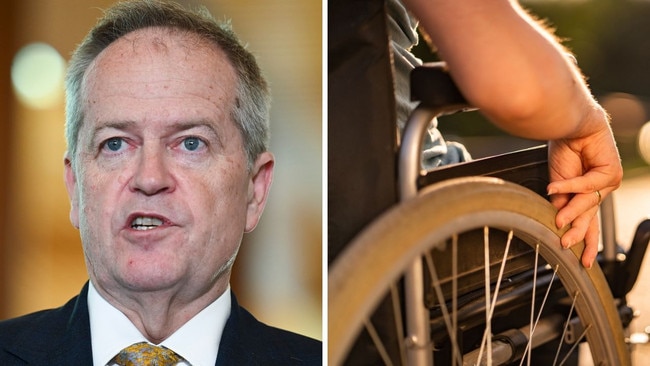Bill relief: $1bn shaved from NDIS as Bill Shorten puts the scheme back on track
Reforms to the NDIS will save more than $1bn from the growing cost of the ballooning scheme, according to new official projections that promise to deliver critical structural savings to the federal budget.

Reforms to the NDIS will shave more than $1bn from the growing cost of the ballooning scheme, according to new official projections that promise to deliver critical structural savings to the federal budget, as the government tries to steer it back toward a sustainable path.
The savings, revealed in the latest Annual Financial Sustainability Report (AFSR) projections, obtained by The Australian, show the scheme is on track to meet targets agreed to by national cabinet last year to curb annual growth to 8 per cent from 2026.
The cost of the NDIS had previously been projected in 2021 to grow by 23 per cent, sparking fears that, within the decade, it would overtake the pension as the single largest budget expenditure item.
The latest National Disability Insurance Agency annual report, due to be released Friday, containing updated AFSR projections, shows the scheme’s cost is expected to be $210.3bn for the four years to June 2028.
This marks a 12 per cent reduction in previously forecast growth of 19 per cent, and represents a $2.3bn saving on previous AFSR projections from June last year.
NDIS Minister Bill Shorten said the AFSR report was confirmation of the reform program aimed at moderating growth in the NDIS and ensuring it was returned to a sustainable financial position. “I am extremely proud that we are well on our way to getting the NDIS back on track,” said Mr Shorten, who will retire from politics at the next election.
“The NDIS will continue to grow, but we had to make sure it worked better for all Australians and didn’t continue to grow at a rate of knots. The scheme now has more than 660,000 people with disability who are participants and is supporting and changing lives. Ensuring scheme sustainability was never about cutting participants’ plans.
“What we have done is got much, much better at managing plan growth and ensuring every dollar is getting to the people for whom it was intended. While there is a lot of work to go, this is significant proof that the scheme growth and expenditure is stabilising and reducing where it needs to.”
While the NDIS will continue to grow, the AFSR shows the scheme overall will see $19bn less spent over the next four years than would have been the case without the reforms. Much of these savings have been attributed to tightening NDIS funding item lists and stopping automatic top-ups. Further reforms would now deliver savings of about $1.1bn beyond what was forecast in the 2024-25 budget.
The savings contained in the report have been attributed to the passing of the NDIS Amendment (Getting the NDIS Back on Track) bill passed by the parliament on August 22. which not only sought to tighten eligibility requirements but also crack down on fraud.
The federal government has been under pressure to reform the NDIS to ensure its financial sustainability after year-on-year cost increases. A review of the scheme called for radical and widespread reforms to the delivery of disability support plans.
One of the most significant reforms was a rewriting of definitions for NDIS supports. The new definitions list what items and services are permitted to be funded by NDIS and what it will not cover.
The scheme has been engulfed in controversy following revelations of fraudulent providers and questionable services being funded under NDIS, including sex work, holidays and other recreational activities.
The new projections include the crackdown on fraud and integrity measures which have saved $56m since June.
The largest savings are in the scheme’s operating expenses which are projected to be $600m less than originally forecast in the 2024-25 budget estimates.
Savings of up to $3bn a year have also been realised through stabilisation of “plan inflation” — overspending caused by a participant burning through their NDIS funding before the end of their plan, then moving to a new plan. Reforms have ended this practice, one of the greatest drivers of cost increases.
More people were also leaving the NDIS as their support needs reduced.
The NDIA annual report says: “Recent and proposed reforms are expected to stabilise the growth in scheme expenses, with the program of work mostly targeted at reducing additional growth in participant plans beyond price-related indexation of plans and increases in participant plans due to changes in circumstances. These reforms are expected to reduce projected scheme expenses by $19.3bn over the four years to 30 June 2028 … total projected scheme expenses are $210.3bn for the four years to June 2028 – approximately $1bn lower than for the same four-year period in the 2024–25 budget projections and $2.3bn lower than in the June 2023 projections.”
The NDIA annual report also reveals it has hired 1200 new public service employees in what it says is a shift to better support for participants. This is a more than 8 per cent increase in the size of the workforce, with the NDIA reporting that more than 55 per cent of the new employees are in frontline roles.
“The reforms and legislative changes this government has introduced (are) putting participants back at the heart of what we’re doing, and these results show we are making significant steps towards a stronger NDIS, one that benefits us all,” Mr Shorten said.
“This government has been determined to improve the NDIS for participants and to make the NDIS stronger with recent legislative changes in the Getting the NDIS Back on Track Bill helping to return the NDIS to its original intent.”





To join the conversation, please log in. Don't have an account? Register
Join the conversation, you are commenting as Logout